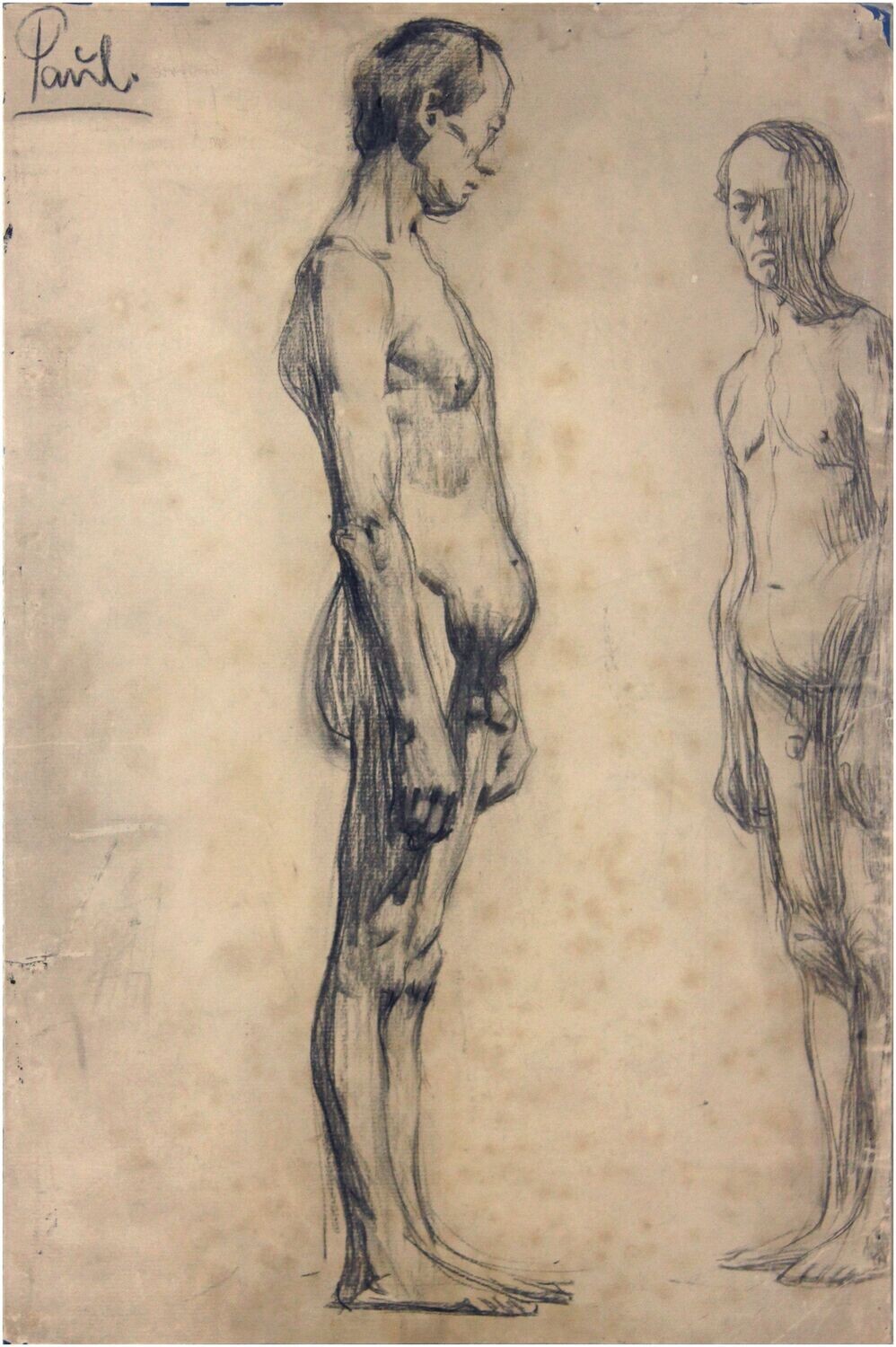Paul, Bruno (1874-1968), Selbstporträt, um 1895
Bruno Paul(1874 Seifhennersdorf - 1968 Berlin). Selbstporträt , um 1895. Bleistift auf Papier, auf Karton aufgezogen, 53,5 x 35 cm, links oben signiert "Paul.".
- Homo nudus -
In einer Spiegelsituation steht sich Bruno Paul innerhalb des Bildes selbst gegenüber. Während sein formatdurchmessender Körper in der bildparallelen Profilansicht gezeigt ist, wendet er sich mit dem Kopf ins Bild hinein, um dort seiner selbst ansichtig zu werden, wobei der leichtere Auftrag des Zeichenwerkzeugs anzeigt, dass es sich hier um eine andere Realitätsebene - eben um ein Spiegelbild - handelt. Die Selbstbegegnung ist eine nüchterne Selbstbetrachtung der eigenen 'nackten Tatsächlichkeit'. Eine Bestandsaufnahme jenseits akademischer Idealisierung, dessen Ausgangs- und Zielpunkt die zugleich an den vom Spiegelbild adressierten Betrachter gerichtete Erkenntnis ist: "Ich bin, der ich bin." Und die eigene Daseinsform weist durchaus Unförmigkeiten auf, die besonders auffällig werden, indem sich Paul in der Schlussstellung porträtiert, was eine akademische Körperbetrachtung geradewegs herausfordert. Pikanterweise hat er diese Selbsterkundung auf der Innenseites des Einbanddeckels einer Mappe für Stickerei-Darstellungen angefertigt, die als Vorlagen zum Studium feiner Schönheitsformen dienen.
Trotz der Realistik einer ungeschönt wahrhaftigen Selbstdarstellung besteht dennoch eine Unfassbarkeit. Der Porträtierte bleibt sich selbst verborgen, wovon der in der Selbstbeobachtung sich selbst gegenüber distanzierte Blick zeugt. Dementsprechend erscheint die eine Gesichtshälfte im Spiegelbild wie ausgelöscht.
Bruno Paul schafft hier ein innerhalb seines Oeuvres einzigartiges Selbstporträt, das in Form einer bildlichen Selbstreflexion auf ergreifende Weise die Erfahrung der Selbstentfremdung der Moderne veranschaulicht.
Alfred Ziffer (Hg.): Bruno Paul. Deutsche Raumkunst und Architektur zwischen Jugendstil und Moderne, Münchner Stadtmuseum, München 1992, Kat. Nr. 5, S. 26. Dort als "Männlicher Akt" von 1894/95 ausgewiesen.
zum Künstler
Aufgrund seiner zeichnerischen Begabung absolvierte Bruno Paul von 1890 bis 1893 eine Ausbildung an der Kunstgewerbeschule Dresden und nebenher ein Praktikum als Bauzeichner. Seit 1894 studierte Paul dann bei Paul Höcker an der Kunstakademie und besuchte parallel dazu Vorlesungen an der Technischen Hochschule. Zwischen 1896 und 1900 lieferte er grafische Beiträge für die „Jugend“ und von 1897 bis 1906 zahlreiche Illustrationen für den „Simplicissimus“. Daneben fertigte er Buchillustrationen und Ausstellungsplakate an.
1898 gründete er zusammen mit Bernhard Pankok, Richard Riemerschmid und Hermann Obrist die "Münchner Vereinigten Werkstätten für Kunst im Handwerk" und entwarf Möbel, Textilien, Tapeten, Teppiche und Metallarbeiten. Zudem gehörte Paul zu den Gründungsmitgliedern der 1903 in Leben gerufenen „Münchner Vereinigung für angewandte Kunst“, deren Zielsetzungen das Programm des "Deutschen Werkbundes" vorwegnahmen, zu dessen Initiatoren Paul ebenfalls gehörte.
Die Auszeichnungen für Raumausstattungen, die Paul in Paris (1900), St. Louis (1904) und Dresden (1906) zu teil wurden, führten 1907 zu seiner Berufung als Leiter der Unterrichtsanstalt am Kunstgewerbemuseum in Berlin, die Wilhelm von Bode, trotz Pauls früherer Karikaturen im Simplicissimus, gegen Kaiser Wilhelm II. durchsetzte. Mit dem Bau und der aufwendigen Ausstattung von „Haus Westend“ für den Direktor der Berliner Filiale der Vereinigten Werkstätten 1908 wurde Paul zum gefragten Architekten des Berliner Großbürgertums, der auch für die Ausstattung von Schiffen der Norddeutschen Lloyd herangezogen wurde. Von 1907 bis 1908 war Ludwig Mies van der Rohe und zwischen 1909 und 1910 der spätere Bauhausarchitekt Adolf Meyer im Architekturbüro Bruno Pauls tätig.
1908 entwickelte Paul das erste „Typenmöbel-Programm“ und 1911 die „Serien-Möbel“, die bis 1942 an den Deutschen Werkstätten in Dresden-Hellerau hergestellt wurden. 1910 wurde Paul mit der künstlerischen Leitung der Deutschen Abteilung auf der Weltausstellung in Brüssel betraut. Nach seiner Aufnahme in die Preußische Akademie der Künste, 1919, verlegte Paul seine Reformbemühungen verstärkt in den Bereich der staatlichen Kunstausbildung und gab die programmatische Schrift „Erziehung der Künstler an staatlichen Schulen“ heraus. 1924 erwirkte er die Vereinigung der Unterrichtsanstalt und der Hochschule der bildenden Künste zur „Vereinigten Staatsschule für freie und angewandte Kunst“ - die heutige Universität der Künste Berlin.
1925 erwarb Paul das „Richmodishaus“ in Köln und richtete in Berlin die „Vereinigten Zoo-Werkstätten“ ein, die zunächst Lampen und später auch Möbel herstellten. Nach internationalen Erfolgen, die Pauls führende Rolle auf dem Gebiet der künstlerischen Wohngestaltung befestigten, musste er mit der Machtergreifung der Nationalsozialisten sein Amt niederlegen. 1937 wurde er zusammen mit Ernst Barlach, Ernst Ludwig Kirchner, Ludwig Mies van der Rohe und Emil Rudolf Weiß als "politisch unzuverlässig" aus der Kunstakademie ausgeschlossen. Dennoch wurde Paul von Adolf Hitler geschätzt, der Paul in dessen "Gottbegnadeten-Liste" aufnahm, was ihn vor einem Kriegseinsatz bewahrte. Nach dem Krieg betätigte sich Paul in Höxter und Düsseldorf als Architekt am Wiederaufbau. Die Berufung zum Präsident der Deutschen Akademie in Berlin-Ost 1948 lehnte er ab. 1955 wurde er von der Akademie der Künste rehabilitiert. 1957 übersiedelte er nach Berlin, wo er 1968 im Alter von 94 Jahren starb.
Auswahlbibliographie
Alfred Ziffer (Hg.): Bruno Paul. Deutsche Raumkunst und Architektur zwischen Jugendstil und Moderne, Münchner Stadtmuseum, München 1992.
Sonja Günther: Bruno Paul. 1874–1968, Berlin 1992.
Andreas Strobl; Barbara Palmbach: Bruno Paul. Simplicissimus, München 2003.
Ralph Musielski: Bau-Gespräche. Architekturvisionen von Paul Scheerbart, Bruno Taut und der "Gläsernen Kette", Berlin 2003.

